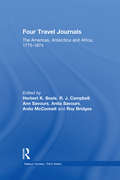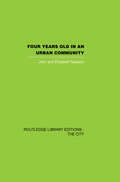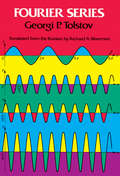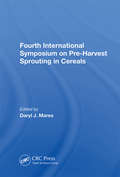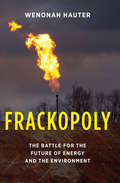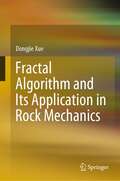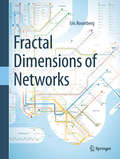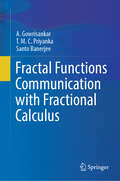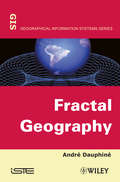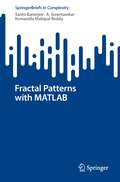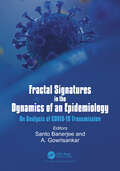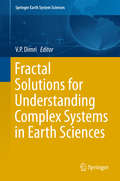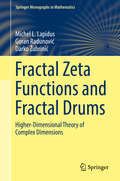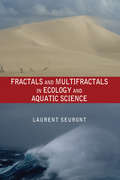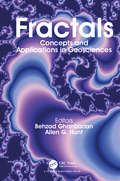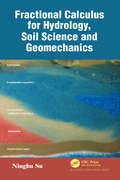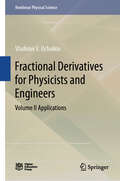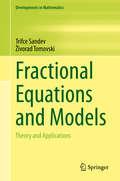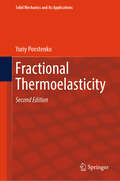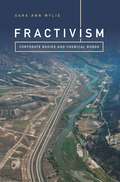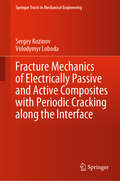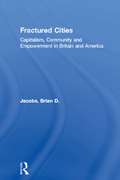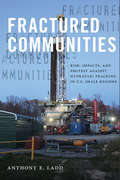- Table View
- List View
Four Travel Journals / The Americas, Antarctica and Africa / 1775-1874 (Hakluyt Society, Third Series)
by R. J. Campbell Anita Mcconnell Ann Savours Herbert K. Beals Roy BridgesThis volume offers annotated texts with biographical and historical introductions of four previously unpublished travel journals from the period 1775-1874. The first of these is the journal of a participant in a Spanish expedition sent from Mexico to explore the north-west coast of America. From the outset, difficulties plagued the voyage. Bodega's ship, a small schooner named Sonora, was not designed for open-ocean voyaging. A landing party was attacked and killed; midway into the voyage the Sonora became separated from her flagship; and later she was nearly capsized by a massive wave. Bodega's journal records the voyage's travails, hardships, discoveries, and eventual return. Next comes the journal of Commander Stokes, who served in command of HMS Beagle, under Captain P. P. King during the survey of the Straits of Magellan in 1827. This is an account of a detached operation, in very difficult weather conditions, in the western part of the strait. It is introduced by remarks on the expedition and the hydrographic history of the strait from its discovery to the inception of the survey and supplemented by remarks from Captain King's account and also that of the clerk, Macdouall. The third text is the journal of a young midshipman in HMS Chanticleer, a small vessel commanded by Henry Foster, RN, who had recently been elected a Fellow of the Royal Society for his scientific work in the Arctic. The voyage of 1828-31 was to make observations in the South Atlantic to determine the shape of the Earth and to ascertain the longitudes of a number of ports. Kay's lively diary describes the Chanticleer's encounters with warships of the Brazilian navy, largely manned by Englishmen. He records his struggle to take observations at Deception Island during gales and snowstorms, and near Cape Horn in fierce squalls and constant chilling rain, nevertheless remaining cheerful in the company of his fellow midshipmen. The final piece is the diary of Jacob Wainwright, the young
Four years Old in an Urban Community
by Elizabeth Newson John NewsonJohn and Elizabeth Newson investigate the upbringing of seven hundred Nottingham children as they reach the age of four. Parents are interviewed in their homes with a realistic yet human approach and the minimum of technical jargon, and the open-ended questions allow them to produce 'a detailed and descriptive study of how parents do in fact treat their children and - equally important - how children treat their parents.' No one can fail to be impressed by the concern and perceptiveness shown by mothers of all classes, different though their approach may be to the common problems of the parent - child relationship. This book was first published in 1968.
Fourier Series
by Georgi P. TolstovRichard A. Silverman's series of translations of outstanding Russian textbooks and monographs is well-known to people in the fields of mathematics, physics, and engineering. The present book is another excellent text from this series, a valuable addition to the English-language literature on Fourier series.This edition is organized into nine well-defined chapters: Trigonometric Fourier Series, Orthogonal Systems, Convergence of Trigonometric Fourier Series, Trigonometric Series with Decreasing Coefficients, Operations on Fourier Series, Summation of Trigonometric Fourier Series, Double Fourier Series and the Fourier Integral, Bessel Functions and Fourier-Bessel Series, and the Eigenfunction Method and its Applications to Mathematical Physics. Every chapter moves clearly from topic to topic and theorem to theorem, with many theorem proofs given. A total of 107 problems will be found at the ends of the chapters, including many specially added to this English-language edition, and answers are given at the end of the text. Richard Silverman's excellent translation makes this book readily accessible to mathematicians and math students, as well as workers and students in the fields of physics and engineering. He has also added a bibliography, containing suggestions for collateral and supplementary reading. 1962 edition.
Fourth International Symposium On Pre-harvest Sprouting In Cereals
by Daryl MaresA major constraint on the production of high-quality grain around the world, pre-harvest sprouting in cereal crops causes substantial economic losses to producers and disrupts the processing, distribution, marketing, and storage of grain products. The solution to this problem must include a better understanding of the phenomenon, the development of
Frackopoly: The Battle for the Future of Energy and the Environment
by Wenonah Hauter&“The definitive story on how big oil and gas corporations captured our political system . . . and the growing grassroots movement to retake our democracy&” (Mark Ruffalo). Over the past decade a new and controversial energy extraction method known as hydraulic fracturing, commonly referred to as fracking, has rocketed to the forefront of US energy production. With fracking, millions of gallons of water, dangerous chemicals, and sand are injected under high pressure deep into the earth, fracturing hard rock to release oil and gas. Wenonah Hauter, one of the nation&’s leading public interest advocates, argues that the rush to fracking is dangerous to the environment and treacherous to human health. Frackopoly describes how the fracking industry began; the technologies that make it possible; and the destruction and poisoning of clean water sources with the release of harmful radiation from deep inside shale deposits, creating what the author calls &“sacrifice zones&” across the American landscape. The book also examines the powerful interests that have supported fracking, including leading environmental groups, and offers a thorough debunking of its supposed economic benefits. With a wealth of new data, Frackopoly is an essential and riveting read for anyone interested in protecting the environment and ensuring a healthy and sustainable future for all Americans. &“A passionate history and critique of the energy industry, from Standard Oil to Enron . . . . [A] journalistic exposé of fracking outrages in which aggressive entrepreneurs in pursuit of profits wreak havoc on the land and poison the water.&” —Kirkus Reviews &“A truly powerful manifesto about one of the greatest environmental fights on our planet today—from one of its greatest champions!&” —Bill McKibben, environmentalist and author of Oil and Honey
Fractal Algorithm and Its Application in Rock Mechanics
by Dongjie XueThis book focuses on learning and adapting nonlinear geometry tool in rock engineering through fractal theories, hypotheses, algorithm, practical understandings, and case studies. Understanding self-similarity and self-affinity is a prerequisite to the fractal model in rock mechanics. The book aims to provide a guide for the readers seeking to understand and build nonlinear model by fractal algorithm. The book is motivated by recent rapid advances in rock engineering in China including application of fractal theory, in addition to percolation theory. It is an essential reference to the most promising innovative rock engineering. Chapters are carefully developed to cover (1) new fractal algorithms (2) five engineering cases. This authored book addresses the issue with a holistic and systematic approach that utilizes fractal theory to nonlinear behavior in rock engineering. The book is written for researchers interested in rock and geological engineering as well as organizations engaged in underground energy practices.
Fractal Dimensions of Networks (Springerbriefs In Computer Science Ser.)
by Eric RosenbergCurrent interest in fractal dimensions of networks is the result of more than a century of previous research on dimensions. Fractal Dimensions of Networks ties the theory and methods for computing fractal dimensions of networks to the “classic” theory of dimensions of geometric objects.The goal of the book is to provide a unified treatment of fractal dimensions of sets and networks. Since almost all of the major concepts in fractal dimensions originated in the study of sets, the book achieves this goal by first clearly presenting, with an abundance of examples and illustrations, the theory and algorithms for sets, and then showing how the theory and algorithms have been applied to networks. Thus, the book presents the classical theory and algorithms for the box counting dimension for sets, and then presents the box counting dimension for networks. All the major fractal dimensions are studied, e.g., the correlation dimension, the information dimension, the Hausdorff dimension, the multifractal spectrum, as well as many lesser known dimensions. Algorithm descriptions are accompanied by worked examples, many applications of the methods are presented, and many exercises, ranging in difficulty from easy to research level, are included.
Fractal Functions Communication with Fractional Calculus
by Santo Banerjee A. Gowrisankar T. M. PriyankaThis book provides an in-depth examination of fractal functions, focusing on their self-similar structures and the relatively simple construction procedures that make them a subject of fascination in mathematics and engineering. By exploring fractal interpolation functions, the book sheds light on naturally occurring phenomena that exhibit irregularity and non-integer dimensions, offering a fresh perspective on these complex mathematical constructs. The chapters cover a range of topics, including the foundational principles of fractal geometry, the construction of fractal functions through iterated function systems, and the critical role of scaling parameters. Readers will find expert analyses of affine and non-affine fractal functions, as well as discussions on the application of fractional calculus methods such as the Riemann-Liouville and Caputo derivatives. The book also explores the practical applications of fractal interpolation in areas like epidemiology and climate dynamics, demonstrating the relevance of these mathematical concepts to real-world problems. This volume is an essential resource for researchers and scholars in mathematics, engineering, and related fields. It offers a comprehensive overview of the current research on fractal functions and fractional calculus, providing readers with the tools to understand and apply these concepts in their work. Whether you are an academic seeking to deepen your knowledge or a practitioner looking to apply fractal functions to practical challenges, this book is a valuable addition to your library. It invites you to engage with the latest research and explore the potential of fractal functions in addressing complex scientific and engineering problems.
Fractal Geography
by André DauphinéOur daily universe is rough and infinitely diverse. The fractal approach clarifies and orders these disparities. It helps us to envisage new explanations of geographical phenomena, which are, however, considered as definitely understood.Written for use by geographers and researchers from similar disciplines, such as ecologists, economists, historians and sociologists, this book presents the algorithms best adapted to the phenomena encountered, and proposes case studies illustrating their applications in concrete situations.An appendix is also provided that develops programs written in Mathematica.Contents1. A Fractal World.2. Auto-similar and Self-affine Fractals.3. From the Fractal Dimension to Multifractal Spectrums.4. Calculation and Interpretation of Fractal Dimensions.5. The Fractal Dimensions of Rank-size Distributions.6. Calculation and Interpretation of Multifractal Spectrums.7. Geographical Explanation of Fractal Forms and Dynamics.8. Using Complexity Theory to Explain a Fractal World.9. Land-use Planning and Managing a Fractal Environment.
Fractal Patterns with MATLAB (SpringerBriefs in Complexity)
by Santo Banerjee A. Gowrisankar Komandla Mahipal ReddyThis book presents the iterative beauty of fractals and fractal functions graphically with the aid of MATLAB programming. The fractal images generated using the MATLAB codes provide visual delight and highly encourage the fractal lovers for creative thinking. The book compiles five cutting-edge research chapters, each with state-of-the art fractal illustrations. It starts with the fundamental theory for the construction of fractal sets via the deterministic iteration algorithm. Incorporating the theoretical base, fractal illustrations of elementary fractal sets are provided with the explicit MATLAB code. The book gives examples of MATLAB codes to present the fractal surfaces. This book is contributed to all the research beginners as well as the professionals on the field of fractal analysis. As it covers basic fractals like Sierpinski triangle to advanced fractal functions with explicit MATLAB code, the presented fractal illustrations hopefully benefit even the non-field readers. The book is a useful course to all the research beginners on the fractal and fractal-related fields.
Fractal Signatures in the Dynamics of an Epidemiology: An Analysis of COVID-19 Transmission
by Santo Banerjee A. GowrisankarThe recent Covid-19 pandemic threw the world into complete chaos with its rapid and devastating spread. Scientists are still trying to obtain a better understanding of the patterns of COVID-19 and trying to get a deeper understanding of mutant strains and their pathogenicity by performing genomic sequences of more samples. Fractal-based analysis provides its unique forecasting policy to reduce the spread of COVID-19, and in general, of any outbreaks. The book presents fractal and multifractal models of COVID-19 and reviews the impact of the pandemic including epidemiology, genome organization, transmission cycle, and control strategies based on mathematical models towards developing an immune intervention. Also, it covers non-clinical aspects such as economic development with graphical illustrations, meeting the needs of onlookers outside the sector who desire additional information on the epidemic. The fractal signatures describe the fractal textures in the patterns of Corona virus. Studies on the epidemiology of Covid-19 in relation with the fractals and fractal functions serve to exhibit its irregular chaotic nature. Moreover, the book with its wide coverage on the Hurst exponent analysis and the fractal dimension estimation, greatly aids in measuring the epidemiology.
Fractal Solutions for Understanding Complex Systems in Earth Sciences
by V. P. DimriThis book deals with fractals in understanding problems encountered in earth science, and their solutions. It starts with an analysis of two classes of methods (homogeneous fractals random models, and homogeneous source distributions or "one point" distributions) widely diffused in the geophysical community, especially for studying potential fields and their related source distributions. Subsequently, the use of fractals in potential fields is described by scaling spectral methods for estimation of curie depth. The book also presents an update of the use of the fractal concepts in geological understanding of faults and their significance in geological modelling of hydrocarbon reservoirs. Geophysical well log data provide a unique description of the subsurface lithology; here, the Detrended Fluctuation Analysis technique is presented in case studies located off the west-coast of India. Another important topic is the fractal model of continuum percolation which quantitatively reproduce the flow path geometry by applying the Poiseuille's equation. The pattern of fracture heterogeneity in reservoir scale of natural geological formations can be viewed as spatially distributed self-similar tree structures; here, the authors present simple analytical models based on the medium structural characteristics to explain the flow in natural fractures. The Fractal Differential Adjacent Segregation (F-DAS) is an unconventional approach for fractal dimension estimation using a box count method. The present analysis provides a better understanding of variability of the system (adsorbents - adsorbate interactions). Towards the end of book, the authors discuss multi-fractal scaling properties of seismograms in order to quantify the complexity associated with high-frequency seismic signals. Finally, the book presents a review on fractal methods applied to fire point processes and satellite time-continuous signals that are sensitive to fire occurrences.
Fractal Zeta Functions and Fractal Drums: Higher-Dimensional Theory of Complex Dimensions (Springer Monographs in Mathematics)
by Michel L. Lapidus Goran Radunović Darko ŽubrinićThis monograph gives a state-of-the-art and accessible treatment of a new general higher-dimensional theory of complex dimensions, valid for arbitrary bounded subsets of Euclidean spaces, as well as for their natural generalization, relative fractal drums. It provides a significant extension of the existing theory of zeta functions for fractal strings to fractal sets and arbitrary bounded sets in Euclidean spaces of any dimension. Two new classes of fractal zeta functions are introduced, namely, the distance and tube zeta functions of bounded sets, and their key properties are investigated. The theory is developed step-by-step at a slow pace, and every step is well motivated by numerous examples, historical remarks and comments, relating the objects under investigation to other concepts. Special emphasis is placed on the study of complex dimensions of bounded sets and their connections with the notions of Minkowski content and Minkowski measurability, as well as on fractal tube formulas. It is shown for the first time that essential singularities of fractal zeta functions can naturally emerge for various classes of fractal sets and have a significant geometric effect. The theory developed in this book leads naturally to a new definition of fractality, expressed in terms of the existence of underlying geometric oscillations or, equivalently, in terms of the existence of nonreal complex dimensions. The connections to previous extensive work of the first author and his collaborators on geometric zeta functions of fractal strings are clearly explained. Many concepts are discussed for the first time, making the book a rich source of new thoughts and ideas to be developed further. The book contains a large number of open problems and describes many possible directions for further research. The beginning chapters may be used as a part of a course on fractal geometry. The primary readership is aimed at graduate students and researchers working in Fractal Geometry and other related fields, such as Complex Analysis, Dynamical Systems, Geometric Measure Theory, Harmonic Analysis, Mathematical Physics, Analytic Number Theory and the Spectral Theory of Elliptic Differential Operators. The book should be accessible to nonexperts and newcomers to the field.
Fractals and Multifractals in Ecology and Aquatic Science
by Laurent SeurontEcologists sometimes have a less-than-rigorous background in quantitative methods, yet research within this broad field is becoming increasingly mathematical. Written in a step-by-step fashion, Fractals and Multifractals in Ecology and Aquatic Science provides scientists with a basic understanding of fractals and multifractals and the techniques fo
Fractals: Concepts and Applications in Geosciences
by Behzad Ghanbarian Allen G. HuntThis book provides theoretical concepts and applications of fractals and multifractals to a broad range of audiences from various scientific communities, such as petroleum, chemical, civil and environmental engineering, atmospheric research, and hydrology. In the first chapter, we introduce fractals and multifractals from physics and math viewpoints. We then discuss theory and practical applications in detail. In what follows, in chapter 2, fragmentation process is modeled using fractals. Fragmentation is the breaking of aggregates into smaller pieces or fragments, a typical phenomenon in nature. In chapter 3, the advantages and disadvantages of two- and three-phase fractal models are discussed in detail. These two kinds of approach have been widely applied in the literature to model different characteristics of natural phenomena. In chapter 4, two- and three-phase fractal techniques are used to develop capillary pressure curve models, which characterize pore-size distribution of porous media. Percolation theory provides a theoretical framework to model flow and transport in disordered networks and systems. Therefore, following chapter 4, in chapter 5 the fractal basis of percolation theory and its applications in surface and subsurface hydrology are discussed. In chapter 6, fracture networks are shown to be modeled using fractal approaches. Chapter 7 provides different applications of fractals and multifractals to petrophysics and relevant area in petroleum engineering. In chapter 8, we introduce the practical advantages of fractals and multifractals in geostatistics at large scales, which have broad applications in stochastic hydrology and hydrogeology. Multifractals have been also widely applied to model atmospheric characteristics, such as precipitation, temperature, and cloud shape. In chapter 9, these kinds of properties are addressed using multifractals. At watershed scales, river networks have been shown to follow fractal behavior. Therefore, the applications of fractals are addressed in chapter 10. Time series analysis has been under investigations for several decades in physics, hydrology, atmospheric research, civil engineering, and water resources. In chapter 11, we therefore, provide fractal, multifractal, multifractal detrended fluctuation analyses, which can be used to study temporal characterization of a phenomenon, such as flow discharge at a specific location of a river. Chapter 12 addresses signals and again time series using a novel fractal Fourier analysis. In chapter 13, we discuss constructal theory, which has a perspective opposite to fractal theories, and is based on optimizationof diffusive exchange. In the case of river drainages, for example, the constructal approach begins at the divide and generates headwater streams first, rather than starting from the fundamental drainage pattern.
Fractional Calculus for Hydrology, Soil Science and Geomechanics: An Introduction to Applications
by Ninghu SuThis book is an unique integrated treatise, on the concepts of fractional calculus as models with applications in hydrology, soil science and geomechanics. The models are primarily fractional partial differential equations (fPDEs), and in limited cases, fractional differential equations (fDEs). It develops and applies relevant fPDEs and fDEs mainly to water flow and solute transport in porous media and overland, and in some cases, to concurrent flow and energy transfer. It is an integrated resource with theory and applications for those interested in hydrology, hydraulics and fluid mechanics. The self-contained book summaries the fundamentals for porous media and essential mathematics with extensive references supporting the development of the model and applications.
Fractional Derivatives for Physicists and Engineers: Volume II Applications (Nonlinear Physical Science)
by Vladimir V. UchaikinThis book brings new perspectives in front of the reader dealing with turbulence and semiconductors, plasma and thermodynamics, mechanics and quantum optics, nanophysics and astrophysics. The first derivative of a particle coordinate means its velocity, the second means its acceleration, but what does a fractional order derivative mean? Where does it come from, how does it work, where does it lead to? The two-volume book written on high didactic level answers these questions. The first volume (ISBN: 978-3-642-33910-3) contains a clear introduction into such a modern branch of analysis as fractional calculus. This second volume develops a wide panorama of applications of the fractional calculus to various physical problems. This book is addressed to students, engineers and physicists, specialists in theory of probability and statistics, in mathematical modeling and numerical simulations, to everybody who doesn't wish to stay apart from the new mathematical methods becoming more and more popular.
Fractional Dynamic Calculus and Fractional Dynamic Equations on Time Scales
by Svetlin G. GeorgievPedagogically organized, this monograph introduces fractional calculus and fractional dynamic equations on time scales in relation to mathematical physics applications and problems. Beginning with the definitions of forward and backward jump operators, the book builds from Stefan Hilger’s basic theories on time scales and examines recent developments within the field of fractional calculus and fractional equations. Useful tools are provided for solving differential and integral equations as well as various problems involving special functions of mathematical physics and their extensions and generalizations in one and more variables. Much discussion is devoted to Riemann-Liouville fractional dynamic equations and Caputo fractional dynamic equations. Intended for use in the field and designed for students without an extensive mathematical background, this book is suitable for graduate courses and researchers looking for an introduction to fractional dynamic calculus and equations on time scales.
Fractional Equations and Models: Theory and Applications (Developments in Mathematics #61)
by Trifce Sandev Živorad TomovskiFractional equations and models play an essential part in the description of anomalous dynamics in complex systems. Recent developments in the modeling of various physical, chemical and biological systems have clearly shown that fractional calculus is not just an exotic mathematical theory, as it might have once seemed. The present book seeks to demonstrate this using various examples of equations and models with fractional and generalized operators. Intended for students and researchers in mathematics, physics, chemistry, biology and engineering, it systematically offers a wealth of useful tools for fractional calculus.
Fractional Thermoelasticity (Solid Mechanics and Its Applications #278)
by Yuriy PovstenkoThis new edition offers expanded coverage of fractional calculus, including Riemann–Liouville fractional integrals, Riemann–Liouville and Caputo fractional derivatives, Riesz fractional operators, and Mittag-Leffler and Wright functions. Additionally, it provides a comprehensive examination of fractional heat conduction and related theories of thermoelasticity. Readers will gain insights into the concepts of time and space nonlocality and their impact on the generalizations of Fourier's law in thermoelasticity. This edition presents a detailed formulation of the problem of heat conduction in different domains and the associated thermal stresses, covering topics such as the fundamental solution to the Dirichlet problem, constant boundary conditions for temperature, and the fundamental solution to the physical Neumann problem. New insights into time-harmonic heat impact on the boundary have also been added. Cracks in the framework of fractional thermoelasticity are also considered.
Fractional-in-Time Semilinear Parabolic Equations and Applications (Mathématiques et Applications #84)
by Ciprian G. Gal Mahamadi WarmaThis book provides a unified analysis and scheme for the existence and uniqueness of strong and mild solutions to certain fractional kinetic equations. This class of equations is characterized by the presence of a nonlinear time-dependent source, generally of arbitrary growth in the unknown function, a time derivative in the sense of Caputo and the presence of a large class of diffusion operators. The global regularity problem is then treated separately and the analysis is extended to some systems of fractional kinetic equations, including prey-predator models of Volterra–Lotka type and chemical reactions models, all of them possibly containing some fractional kinetics. Besides classical examples involving the Laplace operator, subject to standard (namely, Dirichlet, Neumann, Robin, dynamic/Wentzell and Steklov) boundary conditions, the framework also includes non-standard diffusion operators of "fractional" type, subject to appropriate boundary conditions.This book is aimed at graduate students and researchers in mathematics, physics, mathematical engineering and mathematical biology, whose research involves partial differential equations.
Fractivism: Corporate Bodies and Chemical Bonds
by Sara Ann WylieFrom flammable tap water and sick livestock to the recent onset of hundreds of earthquakes in Oklahoma, the impact of fracking in the United States is far-reaching and deeply felt. In Fractivism Sara Ann Wylie traces the history of fracking and the ways scientists and everyday people are coming together to hold accountable an industry that has managed to evade regulation. Beginning her story in Colorado, Wylie shows how nonprofits, landowners, and community organizers are creating novel digital platforms and databases to track unconventional oil and gas well development and document fracking's environmental and human health impacts. These platforms model alternative approaches for academic and grassroots engagement with the government and the fossil fuel industry. A call to action, Fractivism outlines a way forward for not just the fifteen million Americans who live within a mile of an unconventional oil or gas well, but for the planet as a whole.
Fracture Mechanics of Electrically Passive and Active Composites with Periodic Cracking along the Interface (Springer Tracts in Mechanical Engineering)
by Volodymyr Loboda Sergey KozinovThis book offers a comprehensive and timely review of the fracture behavior of bimaterial composites consisting of periodically connected components, i.e. of bimaterial composites possessing periodical cracks along the interface. It first presents an overview of the literature, and then analyzes the isotropic, anisotropic and piezoelectric/dielectric properties of bimaterial components, gradually increasing the difficulty of the solutions discussed up to the coupled electromechanical problems. While in the case of isotropic and anisotropic materials it covers the problems generated by an arbitrary set of cracks, for the piezoelectric materials it focuses on studying the influence of the electric permittivity of the crack’s filler, using not only a simple, fully electrically permeable model, but also a physically realistic, semi-permeable model. Throughout the analyses, the effects of the contact of the crack faces are taken into account so as to exclude the physically unrealistic interpenetration of the composite components that are typical of the classical open model. Further, the book derives and examines the mechanical and electromechanical fields, stress and electric intensity factors in detail. Providing extensive information on the fracture processes taking place in composite materials, the book helps readers become familiar with mathematical methods of complex function theory for obtaining exact analytical solutions.
Fractured Cities: Capitalism, Community and Empowerment in Britain and America
by Brian D. JacobsAnglo-American cities face economic decline, social polarisation and racial conflict. Their fate is increasingly decided by the global actions of transnational corporations and market forces. Community groups find it difficult to gain access to the political system. Ethnic minorities strive for empowerment while indebted city governments battle to maintain basic services. Such is the urban crisis of the 1990s. Fractured Cities describes the political economy of urban change and explores the future of the city.
Fractured Communities: Risk, Impacts, and Protest Against Hydraulic Fracking in U.S. Shale Regions (Nature, Society, and Culture)
by Peter Hall Stephanie A. Malin Suzanne Staggenborg Anthony E. Ladd Hilary Boudet Sherry Cable Brittany Gaustad James Maples Tamara Mix Carmel Price Dakota K.T. Raynes Stacia Ryder Trang Tran Ion Bogdan Vasi Cameron Thomas Whitley Patricia WidenerWhile environmental disputes and conflicts over fossil fuel extraction have grown in recent years, few issues have been as contentious in the twenty-first century as those surrounding the impacts of unconventional natural gas and oil development using hydraulic drilling and fracturing techniques—more commonly known as “fracking”—on local communities. In Fractured Communities, Anthony E. Ladd and other leading environmental sociologists present a set of crucial case studies analyzing the differential risk perceptions, socio-environmental impacts, and mobilization of citizen protest (or quiescence) surrounding unconventional energy development and hydraulic fracking in a number of key U.S. shale regions. Fractured Communities reveals how this contested terrain is expanding, pushing the issue of fracking into the mainstream of the American political arena.
